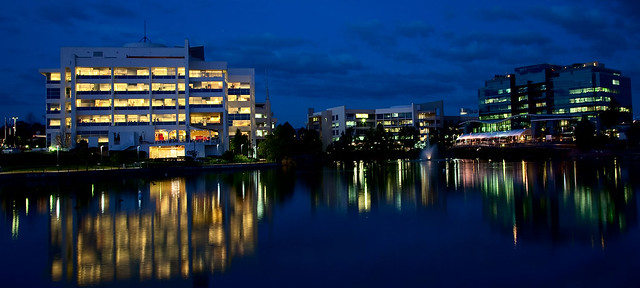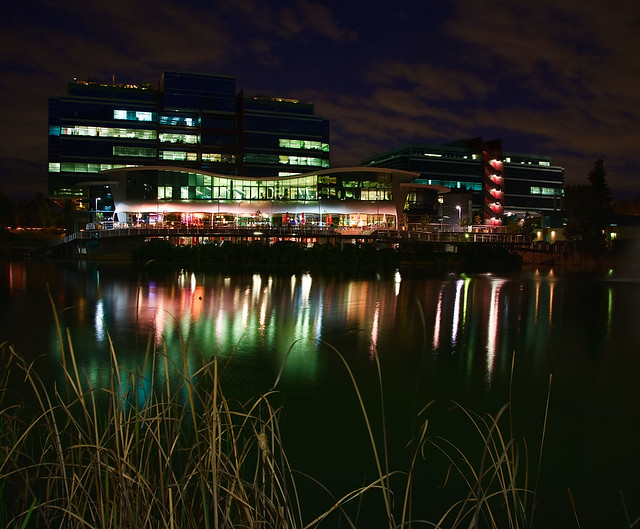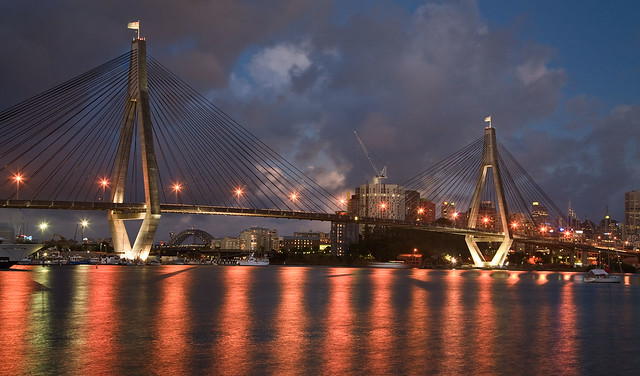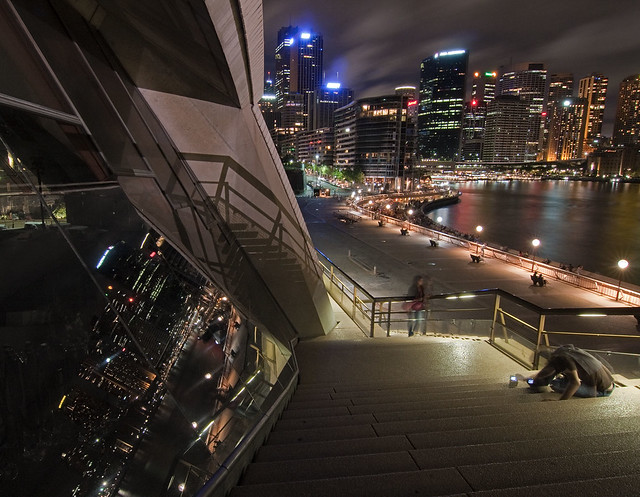Night Photography:1 Cityscapes.
In response to a tutorial request.
This tute will be covering long exposure cityscapes.
(1) When to shoot.
For me the best time to shoot is in the "blue hour", that time just after sunset but before the sky turns black.
I like the fact the sky is not boring black but beautiful deep blue, may have some interest and makes a nice contrast with building lights.
(1.1) During the blue hour (at 5:50PM looking east on a winters day)

Camera Canon EOS 5D
Exposure 8
Aperture f/11.0
Focal Length 28 mm
ISO Speed 100
Exposure Bias 0 EV
(1.2) A bit after near the same location as above but 20 minutes latter, looking south west.

Camera Canon EOS 5D
Exposure 8
Aperture f/7.1
Focal Length 24 mm
ISO Speed 100
Exposure Bias 0 EV
(2) Pre requisites
- be familiar with your camera and its operation. You may be making adjustments in the dark.
- Be able to read and understand the histogram. The pic on the back of your camera is not a good guide for a correctly exposed image.
(3) Equipment.
Any camera that allows manual long exposure and focussing will be fine.
A stable support, tripod, for the camera is an absolute necessity.
A remote for your camera is a lot easier than using the self timer. Touching the camera may cause vibrations which may blur the image.
Take a torch - this will help a lot when working in the dark.
Make sure you have plenty of battery power for your camera.
(4) Setting up your camera.
(4a) Check your camera lens/manual to see if image stabilisation should be turned off when the camera is tripod mounted.
(4b) Manual focus.
(4c) Manual exposure.
(4d) Lowest possible ISO - this is to keep noise to a minimum.
(4e) Remove any filters from the lens and use a lens hood. This will help reduce flare.
(4f) Camera on tripod and remote plugged in.
(4g) I shoot raw to give me more control when PPing the image.
(4h) I use just the centre focus point only active.
(4j) I meter the whole scene however the light meter can be fooled very easily in these conditions so use it just as a guide.
I usually start with an exposure around 10 second @ F8 & ISO 100
(5) shooting.
Focussing may be a problem. Live view may make it easier and try to focus on something that provides some contrast. Not all my cameras have live view so what I do is just partially depress the shutter and rack the lens back & forth while watching the focus indicators in the viewfinder.
I will then take a photograph and then check the histogram.
I will adjust my exposure if needed, and then re shoot.
Bracket your exposures, by at least one stop, it will give you more choices when PPing.
If the light is changing, or the moon rising etc, I will continue shooting, bracketing exposures until the light has gone.
If the light is not changing I will only take a few photographs with a range of exposures (+- up to 3 F stops) to allow possible use of HDR or merging images when PPing.
Some examples.
(5.1) Looking east shortly after sunset (8:34 PM in summer). The moon is rising and helping to light up the clouds.

Camera Canon EOS 5D + Canon 24-105 F4 IS L lens
Exposure 3.2
Aperture f/8.0
Focal Length 45 mm
ISO Speed 200
Exposure Bias 0 EV
(5.2) Well after the "blue Hour". The clouds are being lit up by the city lights. 9:15 PM on a summers night.

Camera Canon EOS 40D + Tokina 12-24 lens
Exposure 15
Aperture f/14.0
Focal Length 12 mm
ISO Speed 400
Exposure Bias 0 EV
Security; always be aware of your surroundings and take care when shooting.
In response to a tutorial request.
This tute will be covering long exposure cityscapes.
(1) When to shoot.
For me the best time to shoot is in the "blue hour", that time just after sunset but before the sky turns black.
I like the fact the sky is not boring black but beautiful deep blue, may have some interest and makes a nice contrast with building lights.
(1.1) During the blue hour (at 5:50PM looking east on a winters day)

Camera Canon EOS 5D
Exposure 8
Aperture f/11.0
Focal Length 28 mm
ISO Speed 100
Exposure Bias 0 EV
(1.2) A bit after near the same location as above but 20 minutes latter, looking south west.

Camera Canon EOS 5D
Exposure 8
Aperture f/7.1
Focal Length 24 mm
ISO Speed 100
Exposure Bias 0 EV
(2) Pre requisites
- be familiar with your camera and its operation. You may be making adjustments in the dark.
- Be able to read and understand the histogram. The pic on the back of your camera is not a good guide for a correctly exposed image.
(3) Equipment.
Any camera that allows manual long exposure and focussing will be fine.
A stable support, tripod, for the camera is an absolute necessity.
A remote for your camera is a lot easier than using the self timer. Touching the camera may cause vibrations which may blur the image.
Take a torch - this will help a lot when working in the dark.
Make sure you have plenty of battery power for your camera.
(4) Setting up your camera.
(4a) Check your camera lens/manual to see if image stabilisation should be turned off when the camera is tripod mounted.
(4b) Manual focus.
(4c) Manual exposure.
(4d) Lowest possible ISO - this is to keep noise to a minimum.
(4e) Remove any filters from the lens and use a lens hood. This will help reduce flare.
(4f) Camera on tripod and remote plugged in.
(4g) I shoot raw to give me more control when PPing the image.
(4h) I use just the centre focus point only active.
(4j) I meter the whole scene however the light meter can be fooled very easily in these conditions so use it just as a guide.
I usually start with an exposure around 10 second @ F8 & ISO 100
(5) shooting.
Focussing may be a problem. Live view may make it easier and try to focus on something that provides some contrast. Not all my cameras have live view so what I do is just partially depress the shutter and rack the lens back & forth while watching the focus indicators in the viewfinder.
I will then take a photograph and then check the histogram.
I will adjust my exposure if needed, and then re shoot.
Bracket your exposures, by at least one stop, it will give you more choices when PPing.
If the light is changing, or the moon rising etc, I will continue shooting, bracketing exposures until the light has gone.
If the light is not changing I will only take a few photographs with a range of exposures (+- up to 3 F stops) to allow possible use of HDR or merging images when PPing.
Some examples.
(5.1) Looking east shortly after sunset (8:34 PM in summer). The moon is rising and helping to light up the clouds.

Camera Canon EOS 5D + Canon 24-105 F4 IS L lens
Exposure 3.2
Aperture f/8.0
Focal Length 45 mm
ISO Speed 200
Exposure Bias 0 EV
(5.2) Well after the "blue Hour". The clouds are being lit up by the city lights. 9:15 PM on a summers night.

Camera Canon EOS 40D + Tokina 12-24 lens
Exposure 15
Aperture f/14.0
Focal Length 12 mm
ISO Speed 400
Exposure Bias 0 EV
Security; always be aware of your surroundings and take care when shooting.
No comments:
Post a Comment